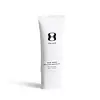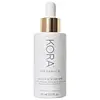What's inside
What's inside
 Key Ingredients
Key Ingredients

 Benefits
Benefits

 Concerns
Concerns

 Ingredients Side-by-side
Ingredients Side-by-side

Zinc Oxide 17.5%
Cosmetic ColorantWater
Skin ConditioningCaprylic/Capric Triglyceride
MaskingGlycerin
HumectantMethyl Dihydroabietate
Cetearyl Alcohol
EmollientCetyl Palmitate
EmollientCoco-Glucoside
CleansingCaprylyl/Capryl Glucoside
CleansingSorbitan Palmitate
EmulsifyingSorbitan Olivate
EmulsifyingButyrospermum Parkii Nut Extract
EmollientEthyl Ferulate
AntioxidantBisabolol
MaskingAllantoin
Skin ConditioningHydrolyzed Jojoba Esters
Skin ConditioningAcacia Senegal Gum
MaskingPolyhydroxystearic Acid
EmulsifyingPolyglyceryl-3 Polyricinoleate
EmulsifyingIsostearic Acid
CleansingLecithin
EmollientTocopheryl Acetate
AntioxidantTetrahexyldecyl Ascorbate
AntioxidantDecapeptide-52
Skin ConditioningOryza Sativa Starch
AbsorbentCamellia Sinensis Leaf Extract
AntimicrobialEuterpe Oleracea Fruit Extract
Caesalpinia Spinosa Fruit Pod Extract
Helianthus Annuus Sprout Extract
Skin ConditioningCaprylyl Glycol
EmollientEthylhexylglycerin
Skin ConditioningHexylene Glycol
EmulsifyingXanthan Gum
EmulsifyingSodium Phytate
Propylene Glycol
HumectantPhenoxyethanol
PreservativeSodium Benzoate
MaskingPotassium Sorbate
PreservativeZinc Oxide 17.5%, Water, Caprylic/Capric Triglyceride, Glycerin, Methyl Dihydroabietate, Cetearyl Alcohol, Cetyl Palmitate, Coco-Glucoside, Caprylyl/Capryl Glucoside, Sorbitan Palmitate, Sorbitan Olivate, Butyrospermum Parkii Nut Extract, Ethyl Ferulate, Bisabolol, Allantoin, Hydrolyzed Jojoba Esters, Acacia Senegal Gum, Polyhydroxystearic Acid, Polyglyceryl-3 Polyricinoleate, Isostearic Acid, Lecithin, Tocopheryl Acetate, Tetrahexyldecyl Ascorbate, Decapeptide-52, Oryza Sativa Starch, Camellia Sinensis Leaf Extract, Euterpe Oleracea Fruit Extract, Caesalpinia Spinosa Fruit Pod Extract, Helianthus Annuus Sprout Extract, Caprylyl Glycol, Ethylhexylglycerin, Hexylene Glycol, Xanthan Gum, Sodium Phytate, Propylene Glycol, Phenoxyethanol, Sodium Benzoate, Potassium Sorbate
Zinc Oxide 17%
Cosmetic ColorantSalvia Hispanica Seed Oil
MoisturisingWater
Skin ConditioningIsoamyl Laurate
EmollientHelianthus Annuus Seed Oil
EmollientCocos Nucifera Oil
MaskingGlycerin
HumectantPolyglyceryl-3 Polyricinoleate
EmulsifyingAlumina
AbrasiveRubus Idaeus Seed Oil
EmollientArgania Spinosa Kernel Oil
EmollientLactobacillus Ferment
Skin ConditioningTocopheryl Acetate
AntioxidantIsostearic Acid
CleansingXylityl Sesquicaprylate
AntimicrobialEctoin
Skin ConditioningPolyhydroxystearic Acid
EmulsifyingRicinoleic Acid
CleansingLactobacillus
Skin ConditioningSilica
AbrasivePolyglyceryl-3 Ricinoleate
EmulsifyingAnhydroxylitol
HumectantBisabolol
MaskingCocos Nucifera Fruit Extract
EmollientAloe Barbadensis Leaf Juice
Skin ConditioningMorinda Citrifolia Fruit Extract
Skin ConditioningPelargonium Graveolens Flower Oil
MaskingSparassis Crispa Extract
Emulsion StabilisingTocopherol
AntioxidantCitronellol
PerfumingBeta-Sitosterol
Emulsion StabilisingOcimum Basilicum Oil
MaskingRosa Centifolia Flower Oil
MaskingGeraniol
PerfumingSqualene
EmollientZinc Oxide 17%, Salvia Hispanica Seed Oil, Water, Isoamyl Laurate, Helianthus Annuus Seed Oil, Cocos Nucifera Oil, Glycerin, Polyglyceryl-3 Polyricinoleate, Alumina, Rubus Idaeus Seed Oil, Argania Spinosa Kernel Oil, Lactobacillus Ferment, Tocopheryl Acetate, Isostearic Acid, Xylityl Sesquicaprylate, Ectoin, Polyhydroxystearic Acid, Ricinoleic Acid, Lactobacillus, Silica, Polyglyceryl-3 Ricinoleate, Anhydroxylitol, Bisabolol, Cocos Nucifera Fruit Extract, Aloe Barbadensis Leaf Juice, Morinda Citrifolia Fruit Extract, Pelargonium Graveolens Flower Oil, Sparassis Crispa Extract, Tocopherol, Citronellol, Beta-Sitosterol, Ocimum Basilicum Oil, Rosa Centifolia Flower Oil, Geraniol, Squalene
Ingredients Explained
These ingredients are found in both products.
Ingredients higher up in an ingredient list are typically present in a larger amount.
Bisabolol is famous for its skin soothing properties. It does this by blocking inflammatory signals, helping to reduce your body's reaction to irritation.
This ingredient also interferes with the process of hyperpigmentation. This can help with reducing dark spots and uneven tone.
Bisabolol is an antioxidant. Antioxidants help fight free-radicals. Free-radicals are molecules that may damage your skin cells. By fighting these free-radicals, Bisabolol may slow down signs of aging.
Studies have shown Bisabolol to have antimicrobial properties and may be a fungicide. These properties help preserve a product's shelf life.
All these properties makes bisabolol a great skin barrier helper ingredient.
Bisabolol also helps the absorption of other ingredients.
Note: Synthetic Bisabolol has been shown to be less effective.
Learn more about BisabololGlycerin is already naturally found in your skin. It helps moisturize and protect your skin.
A study from 2016 found glycerin to be more effective as a humectant than AHAs and hyaluronic acid.
As a humectant, it helps the skin stay hydrated by pulling moisture to your skin. The low molecular weight of glycerin allows it to pull moisture into the deeper layers of your skin.
Hydrated skin improves your skin barrier; Your skin barrier helps protect against irritants and bacteria.
Glycerin has also been found to have antimicrobial and antiviral properties. Due to these properties, glycerin is often used in wound and burn treatments.
In cosmetics, glycerin is usually derived from plants such as soybean or palm. However, it can also be sourced from animals, such as tallow or animal fat.
This ingredient is organic, colorless, odorless, and non-toxic.
Glycerin is the name for this ingredient in American English. British English uses Glycerol/Glycerine.
Learn more about GlycerinIsostearic acid is a saturated fatty acid. Its structure makes it a great surfactant.
Surfactants help decrease the surface tension between two liquids. This property also makes it an effective emulsifier. Emulsifiers help prevent waters and oils from separating in a product.
Isostearic Acid is created from oleic acid.
This ingredient may not be Malassezia folliculitis, or fungal-acne safe.
Learn more about Isostearic AcidThis ingredient is an emulsifier. It is created from Polyglycerin-3 and Ricinoleic Acid.
As an emulsifier, it prevents waters and oils from separating. According to a manufacturer this ingredient is fully biodegradable.
This ingredient may not be safe for Malassezia folliculitis due to its Ricinoleic Acid base. Ricinoleic Acid is a fatty acid derived from castor oil.
Learn more about Polyglyceryl-3 PolyricinoleatePolyhydroxystearic Acid is a soft wax made from castor oil.
It is is a texture thickener, emulsifier, and film-former. Emulsifiers prevent ingredients from separating, such as oils and waters.
Polyhydroxystearic Acid may not be fungal acne safe.
Learn more about Polyhydroxystearic AcidTocopheryl Acetate is AKA Vitamin E. It is an antioxidant and protects your skin from free radicals. Free radicals damage the skin by breaking down collagen.
One study found using Tocopheryl Acetate with Vitamin C decreased the number of sunburned cells.
Tocopheryl Acetate is commonly found in both skincare and dietary supplements.
Learn more about Tocopheryl AcetateWater. It's the most common cosmetic ingredient of all. You'll usually see it at the top of ingredient lists, meaning that it makes up the largest part of the product.
So why is it so popular? Water most often acts as a solvent - this means that it helps dissolve other ingredients into the formulation.
You'll also recognize water as that liquid we all need to stay alive. If you see this, drink a glass of water. Stay hydrated!
Learn more about WaterZinc Oxide is a mineral broad-spectrum UV filter; it is the broadest UVA and UVB reflector approved by the FDA. It also has skin protectant and skin soothing properties.
Zinc oxide is one of the most effective broad-spectrum UV filters. It protects against UVB, UVAII, and UVAI. In comparison to its counterpart titanium dioxide, zinc oxide provides uniform and extended UVA protection.
Another great benefit? This ingredient is highly photostable so it won't degrade easily under sunlight.
A common myth is that mineral UV filters are widely believed to primarily reflect UV light.
However, modern research shows titanium dioxide absorbs UV radiation like chemical filters (~95% absorption & 5% reflection).
Zinc oxide has great skin soothing properties so you'll likely find this in sunscreens formulated for sensitive skin or babies/children. It is unlikely to cause "eye sting" like other sunscreen ingredients.
Regulatory agencies consider zinc oxide to be non-toxic and safe. It has also been shown to not penetrate the skin.
Unfortunately, this ingredient does leave a visible white cast. This is why mineral sunscreens are often less cosmetically elegant than chemical or hybrid ones.
In cosmetics, zinc oxide can be found in both non-nano and nano-sized forms. The nano version is used to reduce white cast and improve the texture of sunscreen formulas.
There are ongoing concerns surrounding nano-zinc oxide's impact on marine ecosystems and whether it can be absorbed into skin.
Regarding marine ecosystems and coral reefs, there is no conclusive evidence that any form of zinc oxide (or any other sunscreen ingredients) will cause harm. The science is still developing but many consumers are keeping a close eye on this issue.
Please note, many destinations have reef-safety sunscreen rules. For instance, the U.S. Virgin Islands advises all visitors to use non-nano mineral sunscreens.
There has also been some stir about whether micronized or nano zinc oxide has potential photoxicity and absorption through the skin/lungs.
An in-vitro (done in a test tube or petri dish) study demonstrated micronized zinc oxide to have potential phototoxicity. There's no need to fret; the EU Commission's Scientific Committee on Consumer Safety has stated, "The relevance of these findings needs to be clarified by appropriate investigations in vivo." Or in other words, further studies done on living organisms are needed to prove this.
Current research shows zinc oxide nanoparticles do not penetrate intact or sunburned skin. They either remain on the surface or in the outermost layer of dead skin (stratum corneum).
Zinc oxide is one of only two classified mineral UV filters with titanium dioxide being the other one.
Fun fact: Zinc has been used throughout history as an ingredient in paint and medicine. An Indian text from 500BC is believed to list zinc oxide as a salve for open wound. The Ancient Greek physician Dioscorides has also mentioned the use of zinc as an ointment in 1AD.
Learn more about Zinc Oxide